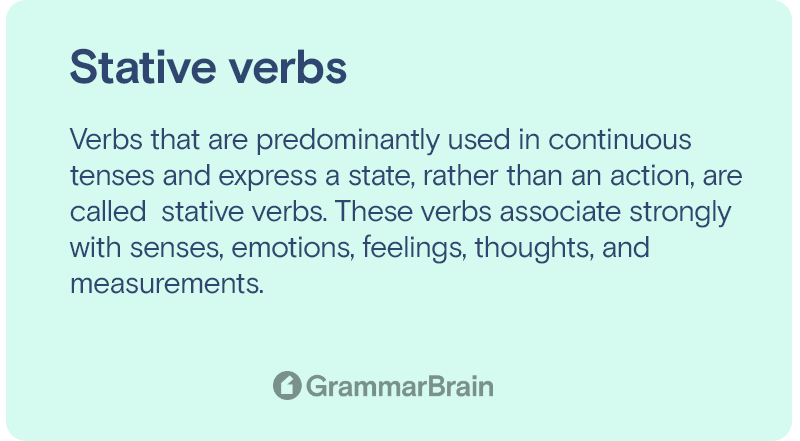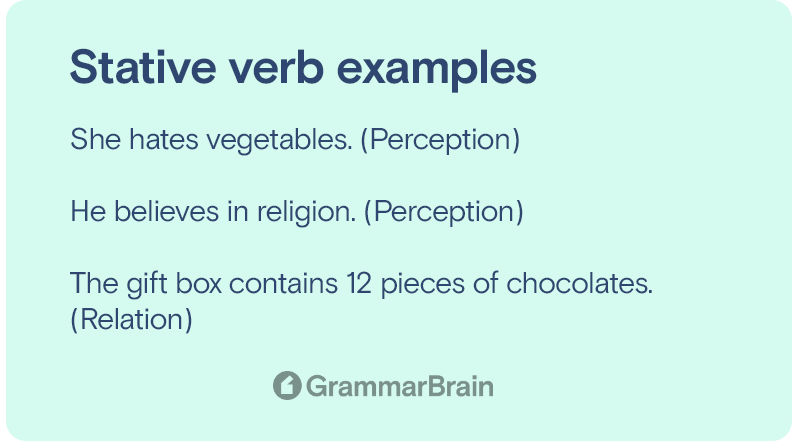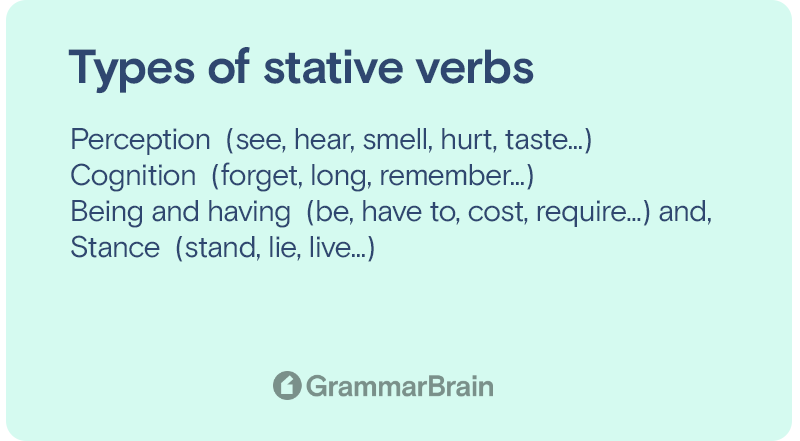What are stative verbs? Most of us know verbs are words that help describe certain actions, be they physical or mental. What many of us don’t know is that there are some verbs that instead of describing an action, convey a ‘state of being’.
These verbs often relate to thoughts, opinions, feelings, and emotions as opposed to actions. In this article, we will learn about these verbs.
So, if you want to take your language proficiency to the next level, continue reading!

What are stative verbs?
Verbs that are predominantly used in continuous tenses and express a state, rather than an action, are called stative verbs. These verbs associate strongly with senses, emotions, feelings, thoughts, and measurements.
Some common examples of stative verbs are as follows:
- depend – I depend on her for most of the work.
- love – Rebecca loves her children just as any mother loves her children.
- hear – Hearing him talk is a lot of fun.
- astonish – The night sky looks astonishingly beautiful.
- disagree – It is alright to disagree with someone now and then.
- satisfy – It does not take much to satisfy him.
- doubt – I doubt he is competent enough.
- wish – I wish he would go back to his other house.
- deny – I don’t deny any of the things you said.
- please – May I please join you, people?
- impress – Does Jeremy impress you with all his skills?
- promise – I promise to spend more time with you from now on.
- surprise – I thought giving her a surprise would be a good idea.
- think – I think it is better to ignore this idea for the time being.
- feel – I feel rather weak and lethargic in the evening.
Here are a few sentence examples with the stative verb highlighted in bold:
- Robert feels horrible today due to the flu.
- How come you didn’t recognize a famous star?
- Our business partner appreciated all the work we did.
- I can smell the delicious homemade sauce from here.
- I understand exactly what you’re trying to say.
Definition of a stative verb
A stative verb is usually defined as “a verb that describes a state and not an action”. The Collins dictionary defines a stative verb as “a verb describing a state rather than an act, activity or event”.

How stative verbs are different from regular verbs?
The key difference between a stative verb and a regular verb is that we use stative verbs less frequently in the continuous verb tenses, i.e. with ‘be’ & ‘-ing’ verb forms.
This means that the sentence – “I am having two cats” will find less use in the English language as compared to the sentence – “I have two cats”. It would sound very odd to use stative verbs to describe the present continuous verb tenses.
Understanding stative verbs and action verbs
Regular verbs are also known as dynamic verbs or action verbs. They are found useful in describing certain activities, processes, or momentary actions.
Some sentence examples using action verbs are as follows:
- Jerome plays badminton every Friday. (activity)
- The pot is boiling right now. (process)
- When a boxer hits his competitor in the head, a concussion can result. (momentary action)
Stative verbs, on the other hand, find use in describing unchanging or static conditions. These conditions can refer to perception (cognition) or relation (relationships between things).

Some sentence examples using stative verbs are as follows:
- She hates vegetables. (Perception)
- He believes in religion. (Perception)
- The gift box contains 12 pieces of chocolates. (Relation)
So, action verbs can be used in simple and perfect forms (watches, watched, has watched, had watched) and also in continuous forms (is watching, was watching, has been watching, had been watching).
However, stative verbs are mainly used in simple and perfect forms. They find limited use in continuous or progressive verb forms.
Difference between stative verbs and action verbs
In a nutshell, a stative verb is used to convey the condition of a subject without describing an action. On the other hand, an action verb functions as a linking verb and acts as a bridge between the subject and the complement of the subject.
An interesting point to note is that objects, concepts, and imaginary characters can also be described with action verbs. For example, the verb “ended” in the sentence – “The book ended after thirty pages of unfunny jokes”, is an action verb even though the book didn’t perform any action.
Examples of stative verbs in sentences
Here are some more examples of stative verbs used in sentences:
- I think that’s a great tactic.
- I love this movie.
- This tea smells delicious.
- Do you have a pencil?
- I can’t believe what she has done.
- I am just sad, I guess.
- I prefer to stay away from religious debates.
- I don’t know much about conspiracy theories.
- I want that new jewelry set for my birthday.
- I can’t imagine a more suitable husband for you.

Classification (types) of stative verbs
Stative verbs can be classified into four distinct categories that convey – senses, emotion, being, and possession. Of course, their classification can be subjective depending on the context of use.
Another route of classification can be separating words that relate to –
- Perception (see, hear, smell, hurt, taste…)
- Cognition (forget, long, remember…)
- Being and having (be, have to, cost, require…) and,
- Stance (stand, lie, live…)
Examples of sensing verbs
These verbs are based on the functions performed by our sense organs – see, hear, smell, taste, seem, sound, look, sense, etc.
Examples of emotion or thought verbs
These include words like – love, hate, adore, like, despise, doubt, feel, belief, forget, remember, long, enjoy, need, think, recognize, prefer, understand, suspect, appear, etc.
Examples of being (quality) verbs
These verbs express states of being such as – be, are, is, weigh, contain, involve, consist, was, were, will be, appear, been, etc.
Examples of possession verbs
These include words like – have, belong, include, own, want, posses, has, etc.
List of stative verbs
Here’s a comprehensive list of commonly used stative verbs:
- adore
- agree
- appear (seem)
- appreciate
- be (exist)
- believe
- belong to
- concern
- consist of
- contain
- cost
- deny
- depend on
- deserve
- detest
- disagree
- dislike
- doubt
- equal
- feel
- hate
- have (possession)
- hear
- imagine
- include
- involve
- know
- lack
- like
- loathe
- look (seem)
- love
- matter
- mean
- measure
- mind
- need
- owe
- own
- possess
- promise
- realize
- recognize
- remember
- resemble
- satisfy
- see
- seem
- smell
- sound
- suppose
- surprise
- taste
- think (opinion)
- understand
- want
- weigh
- wish
Verbs that can be both stative and active
As the English language is full of exceptions & gray areas, some verbs can sometimes be stative and sometimes be active, depending on the context.
Let’s look at the following sentences:
- The committee considered my plan.
- Ryan considers hot dogs to be better than sandwiches.
The verb ‘considered’ in the first sentence, is an action verb as it describes an action by the committee. However, in the second sentence, the verb ‘considers’ is a stative verb as it is describing Ryan’s beliefs rather than describing an action.
Some similar examples are as follows:
- Have
- I have an old bike. (stative)
- I am having a short break. (active)
- See
- Don’t you see any issues with that? (stative)
- We’re seeing Mr. Eisenhower tomorrow morning. (active)
- Be
- She is so fascinating! (stative)
- She is being uncooperative right now. (active)
- Taste
- This tea tastes amazing! (stative)
- The chef is tasting the food. (active)
FAQs
How do you know if a verb is stative?
How do you know if a verb is stative?
An easy way to spot stative verbs is to figure out whether it is describing a “state of feeling” or not. If it does, considering the meaning of the sentence, then it is a stative verb.
What is a non-stative verb?
A verb that describes an ‘action’, instead of a ‘state of feeling’ in a given sentence, is a non-stative verb or an active verb.
Is love a stative verb?
The word ‘love’ describes how a person ‘feels’ about someone or something, so it is a stative verb.
How many types of stative verbs are there?
There are four types of stative verbs – senses, emotion, being, and possession. Their classification can be subjective depending on the context of use.
Can verbs be both action and stative?
Yes, some verbs can function as both stative and active verbs, depending on the meaning of a given sentence.
What is a stative verb?
Simply put, stative verbs describe states or conditions. A verb that isn’t stative is called a dynamic verb. Stative and dynamic verbs are found in many common English sentences and English grammar. Remember that a stative verb describes how something is or seems. Dynamic verbs tell the action. Similar to linking verbs. Most verbs show the action in the sentence.
Inside this article
Fact checked:
Content is rigorously reviewed by a team of qualified and experienced fact checkers. Fact checkers review articles for factual accuracy, relevance, and timeliness. Learn more.
Core lessons
Glossary
- Abstract Noun
- Accusative Case
- Anecdote
- Antonym
- Active Sentence
- Adverb
- Adjective
- Allegory
- Alliteration
- Adjective Clause
- Adjective Phrase
- Ampersand
- Anastrophe
- Adverbial Clause
- Appositive Phrase
- Clause
- Compound Adjective
- Complex Sentence
- Compound Words
- Compound Predicate
- Common Noun
- Comparative Adjective
- Comparative and Superlative
- Compound Noun
- Compound Subject
- Compound Sentence
- Copular Verb
- Collective Noun
- Colloquialism
- Conciseness
- Consonance
- Conditional
- Concrete Noun
- Conjunction
- Conjugation
- Conditional Sentence
- Comma Splice
- Correlative Conjunction
- Coordinating Conjunction
- Coordinate Adjective
- Cumulative Adjective
- Dative Case
- Determiner
- Declarative Sentence
- Declarative Statement
- Direct Object Pronoun
- Direct Object
- Diction
- Diphthong
- Dangling Modifier
- Demonstrative Pronoun
- Demonstrative Adjective
- Direct Characterization
- Definite Article
- Doublespeak
- False Dilemma Fallacy
- Future Perfect Progressive
- Future Simple
- Future Perfect Continuous
- Future Perfect
- First Conditional
- Irregular Adjective
- Irregular Verb
- Imperative Sentence
- Indefinite Article
- Intransitive Verb
- Introductory Phrase
- Indefinite Pronoun
- Indirect Characterization
- Interrogative Sentence
- Intensive Pronoun
- Inanimate Object
- Indefinite Tense
- Infinitive Phrase
- Interjection
- Intensifier
- Infinitive
- Indicative Mood
- Participle
- Parallelism
- Prepositional Phrase
- Past Simple Tense
- Past Continuous Tense
- Past Perfect Tense
- Past Progressive Tense
- Present Simple Tense
- Present Perfect Tense
- Personal Pronoun
- Personification
- Persuasive Writing
- Parallel Structure
- Phrasal Verb
- Predicate Adjective
- Predicate Nominative
- Phonetic Language
- Plural Noun
- Punctuation
- Punctuation Marks
- Preposition
- Preposition of Place
- Parts of Speech
- Possessive Adjective
- Possessive Determiner
- Possessive Case
- Possessive Noun
- Proper Adjective
- Proper Noun
- Present Participle
- Prefix
- Predicate



